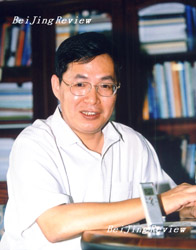
In its effort to become more self-sufficient in energy, China is turning to other countries, notably South Africa, to establish joint ventures in turning coal into oil.
To China's Shenhua Group Corp. Ltd., one of the world's largest coal-producing companies, the government's 11th Five-Year Plan (2006-10) represents the most important stage in its coal liquefaction business as four of its coal-to-oil projects will come into service in the next few years with total annual production of 10-11 million tons of oil.
"Only South Africa, the United States and China have started to commercially produce oil products from coal," Zhang Yuzhuo, Chairman of China Shenhua Coal Liquefaction Corp., told Beijing Review.
Shenhua Group started to develop coal liquefaction projects in 1997 and established China Shenhua Coal Liquefaction Corp. in 2003, the first of its kind nationwide, mainly using direct coal liquefaction technology.
Direct liquefaction technology liquefies coal under high temperatures and high pressure using a catalyst. In contrast, indirect coal liquefaction technology involves gasifying coal and then turning it into fuels and chemical products.
According to Zhang, compared with indirect coal liquefaction, the advantages of direct liquefaction are that its investment, material consumption, water consumption and energy consumption are at least one third lower. Meanwhile, the emission of greenhouse gases is 25 percent less. "Owing to all these advantages, we choose to liquefy coal directly," said Zhang.
Shenhua's first coal-to-oil project approved by the State Council, China's cabinet, can produce 5 million tons of oil products annually. In order to effectively lower the risks, the project is being constructed in stages. Only one production line, with annual output of 1.08 million tons, is currently being built in Ordos, Inner Mongolia Autonomous Region, and is expected to be completed at the end of 2007.
"Though we have our own technology of direct coal liquefaction, there is still no existing coal direct liquefaction factory in the world that we can learn from. So, we must start up our business step by step," Zhang said.
But Sasol Synfuels International of South Africa has a plant that can indirectly liquefy coal. In 2002, Shenhua started negotiations with Sasol regarding a technology transfer and establishing joint ventures. The first stage of feasibility studies, taking one and a half years, has been completed. In July when Chinese Premier Wen Jiabao visited South Africa, the two enterprises signed cooperation agreements on conducting detailed feasibility studies in Yulin, Shaanxi Province, and Ningxia Hui Autonomous Region, where abundant coal reserves are found. The two projects can each produce 3.2 million tons of oil a year, or 70,000 barrels a day, after being put into service.
Meanwhile, Shenhua Ningxia Coal Industry Co. Ltd. (Shenhua-Ningmei) and Shell Gas and Power Development BV signed a joint study agreement for an indirect coal-to-liquids project in Ningxia, using Shell's technology.
"Once all four projects come into production, China will become the No.1 coal-to-oil producer worldwide," Zhang said. Currently, Sasol's annual production is 7-8 million tons. It is the world's only existing coal-to-oil enterprise in service. The WMPI enterprise in the United States, which is under construction, has a comparatively smaller scale.
Significant cooperation
In a statistical sense, China has more oil than Saudi Arabia. The only problem, said Andre de Ruyter, President of Sasol Synfuels International in China, is that China's oil is in the form of coal. "Sasol has the technology to turn that coal into oil," Ruyter told Beijing Review.
According to Zhang, the ratio of oil reserves to oil production in China is very low, but China has abundant coal reserves, with more than 1 trillion tons being verified. China's third resource census shows that economically viable coal reserves total 280 billion tons, mostly located in China's west.
"If you couple the coal reserves and coal mining expertise of the Shenhua Group with the coal processing expertise that Sasol brings to the table, then you will see that Sasol's cooperation with Shenhua is excellent," said Ruyter.
According to Li Yongwang, a chief scientist of coal-to-oil project of Shanxi-based Institute of Coal Chemistry under Chinese Academy of Sciences, against the backdrop of China's lack of oil resources, it is a realistic way to realize the goal of being self-sufficient in oil and oil products.
Sasol has been engaged in this technology for more than 50 years. In the 1940s, the international community imposed economic sanctions on South Africa because of its oppressive apartheid policies. An oil embargo impacted the country greatly and the South African Government was forced to seek alternative ways to supply its oil requirements. In 1950, Sasol was established to specifically research and produce coal liquefaction products. Sasol utilized the technology that was developed in Germany in the 1920s by two scientists, Franz Fischer and Hans Tropsch, who found a way of gasifying coal and then producing various hydrocarbons from the coal.
"This was a very significant process, but it was done on an experimental basis. What Sasol managed to do is to turn it into commercial technology," Ruyter said.
After five years of development, Sasol's first batch of oil products entered the domestic market in 1955. Currently, its technology has reached a high level of maturity and the company has become one of the world's largest chemical material suppliers, producing about 160,000 barrels of liquid fuels and chemicals daily.
"There are other companies that are also pursuing coal-to-liquids projects, but we can say without any degree of exaggeration that we are the only company that has actually done it for more than 50 years," Ruyter said.
"Economically, South Africa's Sasol is an exemplary model for China and even the whole world," said Zhang, adding that "the company has a high return on its coal to liquid business." According to statistics published on its website, sales of the listed company that produces oil from coal last year totaled $11 billion with a net profit of $4.4 billion. "Sasol's success indicates that the coal liquefaction business has a huge profit in case of high international [oil] prices. Economically, the coal-to-oil business has higher value in China," said Zhang.
Research from the United States shows that as long as international oil prices are higher than $28 a barrel, oil made from coal is competitive. "As China's production cost is lower than that in the United States, the figure in China is still lower," Zhang noted.
Coal liquefaction is of great strategic significance to China. Premier Wen said during his inspection tour of Shenhua that the coal-to-oil project is an important part of China's national energy strategic security.
Market needs regulation
"All of our projects are approved by the state. Meanwhile, we currently are the sole state-owned enterprise approved to conduct a coal liquefaction business by the State-Owned Assets Supervision and Administration Commission of the State Council," said Zhang, emphasizing the word "approved."
On July 7, the National Development and Reform Commission (NDRC) issued a document suspending some coal liquefaction projects. "We quite agree with the NDRC's decision and believe it is a very correct decision to regulate the operation of these projects because some enterprises are not capable of operating a coal liquefaction [business]," said Zhang.
After Shenhua began coal liquefaction feasibility studies, many Chinese enterprises followed up, including some small and medium-sized enterprises. More than 10 provinces, municipalities and autonomous regions announced their intention to conduct coal-to-liquid projects. According to the Beijing Research Institute of Coal Chemistry under the China Coal Research Institute, as of July 7, coal liquefaction projects mainly involved Inner Mongolia and Shanxi, Shandong, Xinjiang, Gansu, Heilongjiang, Guizhou, Yunnan and Anhui provinces.
In 2006, some enterprises accelerated their construction of coal to liquid projects. Xuzhou Mining Group planned to build a coal liquefaction project with annual production of 3 million tons of oil products by 2015 and was preparing for the first stage of an oil production line with an annual output of 480,000 tons. Meanwhile, Yitai in Inner Mongolia planned a project to produce 480,000 tons with a total investment of 5 billion yuan. Construction of the first phase, with an annual production of 160,000 tons, started in May. Suddenly, coal-to-liquid projects popped up like mushrooms in China.
Zhang noted that a coal liquefaction project is a long-term program with high risks and heavy investment, which is not suitable for small and medium-sized enterprises. Some of these companies have lowered their investment costs by cutting environmental protection efforts and operate at the cost of harming the environment. "I think it is an important macro-control measure for the state to regulate the coal liquefaction industry in a timely manner," Zhang added.
| 